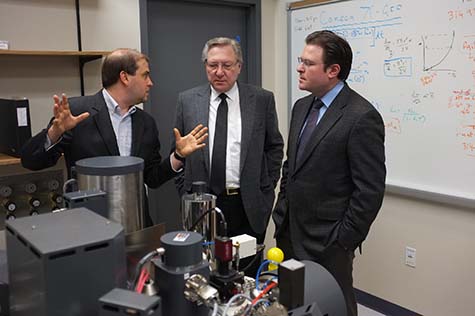
Washington University in St. Louis recently hosted a gathering to dedicate the laboratory space for a fabulous new analytical instrument, naming it for the family whose gift funded the build-out. The Grossman Family SIMS Laboratory houses the Cameca SIMS ims7f-geo, a state-of-the-art secondary-ion mass spectrometer tailored for the analysis of geological samples.
In a sense, the SIMS is just a microscope, not unlike the ones in high school biology labs, but it is a microscope so powerful it lets scientists “see” the chemical composition of samples no bigger than a red blood cell.
Inside the instrument, a beam of charged atoms (called primary ions) knocks atoms out of the sample under study. Some of these atoms are ionized in the process, and these secondary ions are sent through a mass spectrometer that allows their chemical identity and original location to be identified.
One of the 7f-geo’s strengths is the ability to distinguish among isotopes, variants of the same chemical element that vary ever so slightly in mass. Many biological and geological processes “prefer” certain isotopes, and thus leave behind vital clues to events that otherwise would be lost to time.
https://www.youtube.com/watch?v=kPj_JKUa6FM
But the SIMS is a versatile instrument, and a quarter of its time will be available to members of the Institute of Materials Science and Engineering (IMSE), to study problems in the design and processing of materials.
Established in July 2013, IMSE will foster a culture of interdisciplinary materials science research and education at the university. The IMSE’s user facilities in Rudolph Hall eventually will house a suite of instruments for materials characterization, from workhorses of materials science to state-of-the-art equipment with dedicated faculty.
Two of the planned instruments, a 3-D atom probe and an aberration-corrected transmission electron microscope, will allow users to explore and image materials at the level of individual atoms.
The ability to see how materials are put together at many different scales — down to the atoms — will allow scientists to control their properties at the human scale, giving them the toughness, stickiness or other properties needed for demanding applications.
New materials will be crucial to medicine, from biocompatible materials for prostheses or artificial organs to materials for protective gear that can prevent traumatic brain injury. Materials also will be key to developing sources of clean energy, from better catalysts for the production of biofuels to novel high-efficiency solar photovoltaics and portable energy storage devices.
It’s not difficult to think of important problems whose solution will turn on the development of new materials; the difficulty is rather thinking of ones that will not.